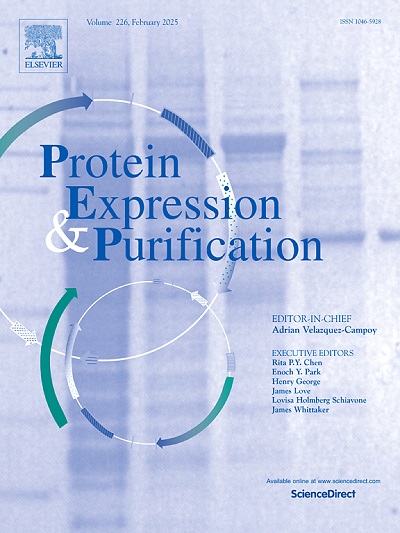Efficient synchronization of high expression and site-specific biotinylation of the PTBP1 RRM3/4 domain
IF 1.2
4区 生物学
Q4 BIOCHEMICAL RESEARCH METHODS
引用次数: 0
Abstract
Polypyrimidine tract-binding protein 1 (PTBP1), a key regulator of mRNA alternative splicing, has emerged as a promising therapeutic target for neurodegenerative diseases and cancer treatment. Given the critical role of its RRM4 domain's lysine residues in binding to polypyrimidine single-stranded RNA, nonspecific biotinylation could potentially alter PTBP1's activity. Here, we describe a method for the concurrent high-level expression and site-specific biotinylation of the PTBP1 RRM3/4 domain using the pQE80L vector and AVB101 host strain. By optimizing codon usage and GC content, we achieved a maximum expression level of approximately 85 μg/mL in bacterial culture, with over 99 % purity and a 72.4 % biotinylation rate. The recombinant 6His-AviBiotin-PTBP1 demonstrated the ability to emit chemiluminescence when coupled with HRP-streptavidin, to be immunoprecipitated by streptavidin magnetic beads, and to interact specifically with (CU)8 RNA, exhibiting a dissociation constant (KD) of 38 nM as determined by Bio-Layer Interferometry (BLI). Collectively, these results indicate that the recombinant 6His-AviBiotin-PTBP1 is suitable for inhibitor screening and kinetic parameter analysis.
PTBP1 RRM3/4结构域的高表达和位点特异性生物素化的高效同步
多嘧啶束结合蛋白1 (PTBP1)是mRNA选择性剪接的关键调节因子,已成为神经退行性疾病和癌症治疗的一个有希望的治疗靶点。鉴于其RRM4结构域赖氨酸残基与多嘧啶单链RNA结合的关键作用,非特异性生物素化可能潜在地改变PTBP1的活性。在这里,我们描述了一种利用pQE80L载体和AVB101宿主菌株同时高水平表达PTBP1 RRM3/4结构域和位点特异性生物素化的方法。通过优化密码子的使用和GC含量,我们在细菌培养中获得了约85 μg/mL的最大表达量,纯度超过99%,生物素化率为72.4%。重组6His-AviBiotin-PTBP1与HRP-streptavidin偶联时具有化学发光的能力,可被streptavidin磁珠免疫沉淀,并与(CU)8 RNA特异性相互作用,通过生物层干涉法(BLI)测定其解离常数(KD)为38 nM。综上所述,这些结果表明重组6His-AviBiotin-PTBP1适合用于抑制剂筛选和动力学参数分析。
本文章由计算机程序翻译,如有差异,请以英文原文为准。
求助全文
约1分钟内获得全文
求助全文
来源期刊

Protein expression and purification
生物-生化研究方法
CiteScore
3.70
自引率
6.20%
发文量
120
审稿时长
32 days
期刊介绍:
Protein Expression and Purification is an international journal providing a forum for the dissemination of new information on protein expression, extraction, purification, characterization, and/or applications using conventional biochemical and/or modern molecular biological approaches and methods, which are of broad interest to the field. The journal does not typically publish repetitive examples of protein expression and purification involving standard, well-established, methods. However, exceptions might include studies on important and/or difficult to express and/or purify proteins and/or studies that include extensive protein characterization, which provide new, previously unpublished information.
 求助内容:
求助内容: 应助结果提醒方式:
应助结果提醒方式:


